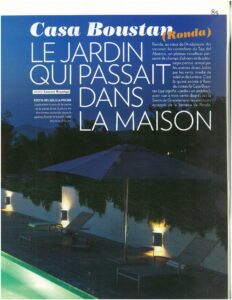El lugar
La finca está situada en una ladera pronunciada de Este a Oeste sobre areniscas calizas del Terciario. Antes de la construcción de los jardines era un olivar-almendral y básicamente lo sigue siendo, pues los jardines se encuentran integrados entre estos árboles, y se han plantado más olivos y almendros en zonas donde no los había. Es una finca sin pozo y el riego se realiza mediante un sistema de recolección del agua de lluvia que es almacenada en grandes depósitos de goma en la parte baja de la finca así como en un aljibe y que se impulsa a otro situado en la parte más alta, para posteriormente regar mediante riego localizado, por gravedad.
Un diseño respetuoso con el paisaje e integrado en él
En el diseño ha sido prioritario dejar diáfanas las impresionantes vistas de las Sierras. Se han utilizado plantas de bajo consumo en agua, perteneciendo en su mayoría a la vegetación autóctona de la Serranía de Ronda, a excepción de algunas como árboles frutales, una mimosa, un falso pimentero, un árbol del amor, un calistemón y una pequeña pradera de bella alfombra próxima a la piscina que hace las funciones de césped pero que necesita mucho menos agua.
Un diseño para ahorrar agua
Puede llamar la atención en el diseño las distancias generosas entre unas plantas y otras al objeto de que, al desarrollarse éstas, manifiesten individualmente su morfología, además al ser su número menor también se utilizan menos goteros, lo que a su vez repercute en menos gasto de agua y menos coste de mantenimiento. Así mismo, estas distancias entre plantas permite que pase el viento seco y caliente estival y no se desarrollen plantas adventicias entre ellas. éstas a veces son muy difíciles de eliminar como ocurre con la grama y la castañuela.
ENGLISH
Farm located in the Serranía de Ronda on a steep slope from East to West on Tertiary limestone sandstones. It was an olive-almond grove and basically still it is, since the gardens are integrated between these trees. It is a farm without a well, so irrigation is carried out through a rainwater collection system that is stored in large rubber tanks in the lower part of the farm and then pumped up to another located in the highest part, from this upper tank the water is used by means of localized irrigation, by gravity.
A design integrated into the landscape and respectful with it.
In the design, it has been a priority to leave the impressive views of the Sierras clear. Plants with low water consumption have been used, most of which belong to the native vegetation of the Serranía de Ronda, with the exception of some such as fruit trees, a mimosa, a false pepper tree, a love tree, a calistemon and a small meadow of Lippia nodiflora next to the swimming pool doing the functions of grass but needing much less water.
A design to save water
The generous distances between plants can draw attention in the design so that, when these develop, they individually manifest their morphology, in addition to being their smaller number, fewer drippers are also used, which in turn has an impact on less expense of water and less maintenance cost. Likewise, these distances between plants allow the dry and hot summer wind to pass and weed plants do not develop between them. these are sometimes very difficult to eliminate as is the case with grass and castanets.




